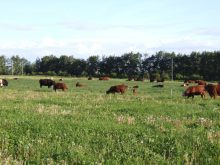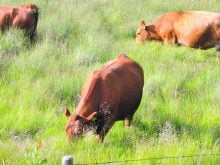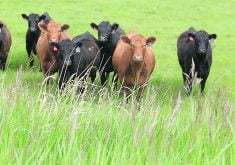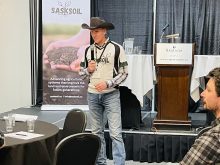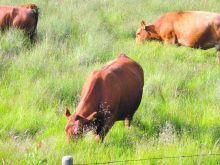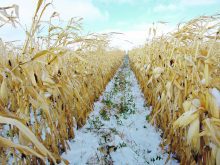Picture it: the cattle out feeding themselves on swaths this winter while you, the cattle rancher, have that extra cup of morning java without having to face the cold, start the tractor and haul bales.
And it’s cheaper too, given that 65 to 75 percent of cattle production costs come from feed, pasture and bedding.
Swath grazing reduces winter feeding costs so those who intend to use that method need to plan for it this spring.
Choices of field, crop type and seeding date have to be made now for successful grazing this fall and winter.
Read Also

Beef check-off collection system aligns across the country
A single and aligned check-off collection system based on where producers live makes the system equal said Chad Ross, Saskatchewan Cattle Association chair.
The field selected should have a water source and wind protection, for starters, said former Agriculture Canada research scientist Duane McCartney, who carried out research on winter grazing in Melfort, Sask., and Lacombe, Alta.
If there are no natural windbreaks, portables can be placed later but a water source is vital.
“You can successfully winter cows on snow, but it’s got to snow,” he said, noting occasions when ranchers had to haul water to cattle all winter in years with low snowfall.
“You need to be able to set the field configuration up in such a way that they can get back home or get to a water source somehow if you don’t have sufficient snow.”
McCartney also recommended the use of portable fencing to limit cattle access to swaths so feed quality remains high.
“The more cow grazing days you get on an acre of land the better you are, so we really stressed using electric fences to limit the amount of feed that cows have access to each day,” he said.
“But when I drive through the country I see very, very few people using electric fences. They turn their cows out into a section or a quarter section of land and they just kind of leave them there.
“The big problem with that is the cows will go and eat all the grain heads first and then have the straw left for the rest of the winter.”
Portable fencing can be used to provide about three days worth of feed for the herd before moving it.
Agriculture Canada research scientist Vern Baron said there is a caveat on expecting cattle to clean up all available feed before moving them to the next spot.
He has found that cattle prefer certain varieties of cereals to others so choice of crop to plant this spring should be made carefully.
“We’ve really seen some popular forage types of barleys that are not consumed and this really is an issue,” said Baron, noting pregnant cows have to eat enough for themselves and for their fetuses over winter.
“Just because varieties are advertised as forage types doesn’t necessarily mean they’re the ones to use.”
At the Agriculture Canada Lacombe Research Centre, Baron and his colleagues have found that cattle consistently use 80 percent of triticale when used as a swath grazing crop, despite oft-heard producer claims that cattle don’t eat it.
In central Alberta, triticale has fairly consistently yielded about 20 percent more than barley. However, if barley is the choice, then two-row tends to be better than six-row, at least in the black soil zone, he said.
Corn, though twice as expensive as cereals to grow, has high yield and good nutritional quality and tends to retain that quality over a longer period than cereals.
Choice of crop will depend on the region and soil type. Whatever yields the most is likely the best bet. Successful swath grazing requires a big swath for best cattle access.
Crops for swath grazing should be cut at the soft dough stage, and as close to the date of killing frost as possible. That means seeding in mid-to-late May to mid-June, depending on type of crop.
McCartney said seeding date is critical so calculating the seeding date based on expected first frost date is the way to go.
“Triticale takes longer to grow so it’s basically more flexible as far as seeding date is concerned,” he said.
And don’t ignore fertility, said Baron.
Many producers think they don’t need to fertilize crops planted for swath grazing because cattle manure suffices.
“Sometimes that may be true and sometimes it isn’t,” he said.
Karin Lindquist, a forage and beef specialist with Alberta Agriculture, said an exit strategy should be considered in case the crop intended for swath grazing doesn’t provide enough feed.
She also recommended training cattle this summer to respect electric fencing so there are fewer problems with escapees in winter.






